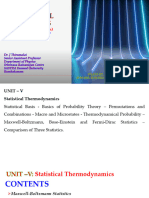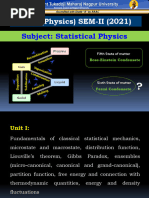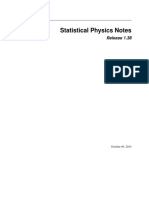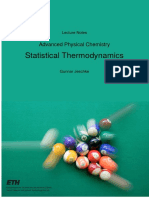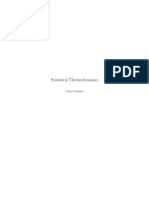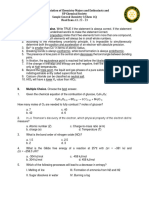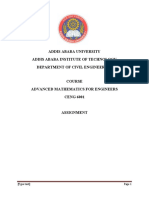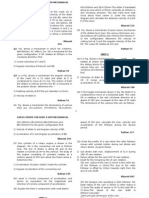Lecture 2
Uploaded by
hidanwfLecture 2
Uploaded by
hidanwfFebruary 05 Lecture 2 1
Lecture 2:
Lecture 2:
Intro. Statistical Mechanics
Intro. Statistical Mechanics
Statistical mechanics: concepts Statistical mechanics: concepts
Aims: Aims:
A microscopic view of entropy:
Joule expansion reviewed.
Boltzmanns postulate.
S = k ln g.
Methods:
Calculating arrangements;
Stirlings formula;
Fluctuations.
Assemblies of quantum oscillators.
N
N
ln(N!)
N!/10^6
N N N N ln ! ln
) log(g k S =
February 05 Lecture 2 2
Joule expansion
Joule expansion
Entropy and configuration: Entropy and configuration:
Review Joule expansion of ideal gas.
2 degenerate states per molecule: 2 degenerate states per molecule:
Take an ideal gas and double its volume:
For 1 mole: (contains N molecules)
S = R ln(2V/V) = R ln 2.
Boltzmann: Boltzmann: associated the increase in entropy
with the increased number of arrangements of the
molecules, g.
In the present example we have N molecules
The initial g arrangements become 2
N
g finally.
Entropy for final system (parts 1 and 2)
S = S
1
+ S
2
while the arrangements behave like
g = g
1
.g
2
.
Guess: S = k ln g. k = const.
February 05 Lecture 2 3
Proof of
Proof of
k
k
ln
ln
g
g
guess.
guess.
( ) ( ) [ ]
N R k
Nk
g g k S
N
=
=
=
2 ln
ln 2 ln
Boltzmanns constant
Boltzmanns constant
In the Joule expansion above,
Proof of Proof of ln ln g g guess: guess:
If, S = f(g)
S = S
1
+ S
2
g = g
1
.g
2
f(g) = f(g
1
.g
2
) = f(g
1
) + f(g
2
).
Differentiate w.r.t. g
1
,
g
2
f(g
1
. g
2
) = f(g
1
)
Differentiate w.r.t. g
2
,
f(g
1
g
2
) + g
1
.g
2
f(g
1
. g
2
) = 0
f(g) = -f(g)/g
f(g) = k/g
f(g) = k ln g + const.
February 05 Lecture 2 4
Calculating number of
Calculating number of
arrangements (Maths revision)
arrangements (Maths revision)
1 less to choose from, etc.
1 less to choose from, etc.
1st choice from N objects
1st choice from N objects
N
N
N!/10^6
ln(N!)
Factorials: Factorials:
Number of ways of selecting N distinguishable
objects:
N.(N-1).(N-2)1 = N!
Combinations: Combinations: (order unimportant)
E.g. distribute N distinguishable objects
between 2 boxes. n
1
in 1st box, and n
2
(=N-n
1
) in
second box.
Using earlier result.
February 05 Lecture 2 5
ways irrespective of order
ways irrespective of order
Combinations
Combinations
(Revision) (Revision)
The result from this argument,
N.(N-1)....(N-n
1
-1).(N-n
1
).(N-n
1
-1).1 = N!
depends on the order (as before)
If there are g arrangements independent of
order,
g(n
1
,n
2
) n
1
! n
2
! = N!
(Same as
n
C
r
= n!/r!(n-r)!, no. of ways of
selecting r from n irrespective of order)
Generalisation to N particles in r boxes
N.(N-1)..(N-n
1
+1)
N.(N-1)..(N-n
1
+1)
(N-n
1
).(N-n
1
-1)..1
(N-n
1
).(N-n
1
-1)..1
x
x
ways of arranging n
2
ways of arranging n
2
ways of arranging n
1
ways of arranging n
1
( )
( )! !
!
! !
!
,
1 1 2 1
2 1
n N n
N
n n
N
n n g
= =
( )
= =
i
r
n N
n n n
N
g ,
! ! !
!
2 1
A
A
February 05 Lecture 2 6
Stirlings approximation
Stirlings approximation
(Revision) (Revision)
Dealing with large factorials. Dealing with large factorials.
N!, when N is large:
For our purposes N~10
24
. It is an excellent
approximation.
[ ]
2 / 1
2 / 1
2 / 1
2 / 1
ln d ln
ln 2 ln 1 ln ! ln
+
+
=
+ + =
}
N
N
x x x x x
N N
N N N N ln ! ln
Stirlings approximation
Stirlings approximation
((n ln n - n)/n!)/10
-6
February 05 Lecture 2 7
N=6x10
23
Distribution function
Distribution function
between chambers
between chambers
How many molecules in each chamber? How many molecules in each chamber?
The numbers must fluctuate (while N is clearly
fixed). Let us calculate the deviation from ideal
partitioning, n.
Box 1 with (N/2+n); Box 2 with (N/2-n).
Using previous result, A, and Stirling:
Using ln(1+x) x-x
2
/2 +.. For small x.
A sharply-peaked
Gaussian.
( )
( ) ( )
( )
( ) ( )
( ) ( )
( ) ( )
( ) ( ) N n n N
N n n N N
n N n N n N
n N n N n N
N N N g
n N n N
N
n n g
/ 2 1 ln 2 /
/ 2 1 ln 2 / 2 ln
2 / 2 / ln 2 /
2 / 2 / ln 2 /
ln ln
! 2 / ! 2 /
!
,
2 1
+ + =
+
+ + + +
+
=
( )
( ) N n g
N n g
N
N
2
2
2 exp 2
2 2 ln ln
February 05 Lecture 2 8
2 non
2 non
-
-
degenerate states
degenerate states
What if the 2 chambers have different What if the 2 chambers have different
energies? energies?
For example molecules in the right chamber
have extra potential energy mgh.
The entropy comes from S = k ln g.
Free Energy F = U - TS is minimised at
equilibrium. (See also Q6, sheet 1.)
Boltzmann distribution (to be derived more
formally later).
( ) ( ) ( )
[ ] ) 1 ln( ) 1 ( ln
! ! 1
!
ln
f f f f Nk
Nf f N
N
k S
+
|
.
|
\
|
=
[ ]
( ) kT
f
f
f F
f f f f NkT Nf F
/ exp
1
0
) 1 ln( ) 1 ( ln
=
+ + =
February 05 Lecture 2 9
Quantum oscillators
Quantum oscillators
Commence a systematic presentation of Commence a systematic presentation of
statistical mechanics. statistical mechanics.
Counting microstates: Counting microstates: (easier in a quantised
system)
weakly interacting assembly of quantum
oscillators. I.e.
They interact to exchange energy, BUT
Energy levels of each oscillator unaffected by
the interaction.
For simplicity take energy levels equally
spaced =m, Separation E= .
Example: Example:
5 oscillators sharing 4 quanta.
N.B. Even with this small number a Boltzmann
distribution emerges. 0 quanta most likely.
Oscillator No 1 2 3 4 5 No. of states
4 0 0 0 0 5
3 1 0 0 0 20
2 2 0 0 0 10
2 1 1 0 0 30
1 1 1 1 0 5
Total no. of microstates 70
February 05 Lecture 2 10
Counting microstates
Counting microstates
Counting states: Counting states:
Represent quanta as x and divided into
oscillators by |. Eg last 2 lines of table;
|xx |x |x | | |
|x |x |x |x | |
Have N-1 boundaries separating the quanta
(Always have 2 boundaries on the outside).
Need to know No. of arrangements of N-1
boundaries and m quanta.
( = 8!/4!4! = 70, for N = 5, m = 4)
Distribution for one Distribution for one- -oscillator. oscillator.
( )
( ) ! ! 1
! 1
) , (
m N
m N
m N g
+
=
0 qu: {(4/5 x 5) + (3/5 x 20) + (3/5 x 10) + (2/5 x 30) + (1/5 x 5)}/70 = 0.5
1 qu: {(0/5 x 5) + (1/5 x 20) + (0/5 x 10) + (2/5 x 30) + (4/5 x 5)}/70 = 0.29
2 qu: {(0/5 x 5) + (0/5 x 20) + (2/5 x 10) + (1/5 x 30) + (0/5 x 5)}/70 = 0.14
3 qu: {(0/5 x 5) + (1/5 x 20) + (0/5 x 10) + (0/5 x 30) + (0/5 x 5)}/70 = 0.06
4 qu: {(1/5 x 5) + (0/5 x 20) + (0/5 x 10) + (0/5 x 30) + (0/5 x 5)}/70 = 0.01
Boltzmann distribution
Boltzmann distribution
February 05 Lecture 2 11
Concluding remarks
Concluding remarks
Direct calculation of the number of ways of
getting, for example, 2 quanta = no. of ways of
giving remaining 2 quanta (i.e. m-1 quanta) to
remaining 4 oscillators (i.e. N-1 osc.).
= (4-1+2)! / (4-1)! (2)! = 5! / 3! 2! = 10
General calculation General calculation
Number of ways an oscillator gets n quanta,
when m quanta are distributed between N
oscillators is:
Note on Q. 3(d), sheet 1 Note on Q. 3(d), sheet 1
Asks how energy is partitioned between two
systems (N
1
and N
2
oscillators respectively),
when the two are in thermal equilibrium.
Evidently, if they have m1 and m2 quanta, we
expect m
1
/ N
1
= m
2
/ N
2
.
Look at ln(g(m
1
) and maximise
Sharpness (curvature) of peak
( ) { }
( ) { } ( )
( )
)! ( )! 2 (
! 2
! ! 1 1
! 1 ) ( 1
n m N
m N
n m N
n m N
+
=
+
( ) 0 ln
1 1
= m m g
( )
peak
m m g
2
1 1
2
ln
You might also like
- Statistical Mechanics in ThermodynamicsNo ratings yetStatistical Mechanics in Thermodynamics61 pages
- Classical Statistics of Maxwell-BoltzmannNo ratings yetClassical Statistics of Maxwell-Boltzmann22 pages
- PVB301 2021 W8 Quantum Statistical MechanicsNo ratings yetPVB301 2021 W8 Quantum Statistical Mechanics44 pages
- Statistical Mechanical Ensembles: 1. Microscopic Origin of EntropyNo ratings yetStatistical Mechanical Ensembles: 1. Microscopic Origin of Entropy22 pages
- Lecture Notes For Statistical Mechanics Fall 2010100% (1)Lecture Notes For Statistical Mechanics Fall 201055 pages
- Lecture Notes On Statistical Physics by Peter JohanssonNo ratings yetLecture Notes On Statistical Physics by Peter Johansson66 pages
- Statistical Mechanics: " $% ' LN+ /+ $/ LN + /+No ratings yetStatistical Mechanics: " $% ' LN+ /+ $/ LN + /+9 pages
- Historical Prospective Boltzmanns Versus PlancksNo ratings yetHistorical Prospective Boltzmanns Versus Plancks14 pages
- Physics 101B. Modern Physics. Professor Dine: 1 Stirling's FormulaNo ratings yetPhysics 101B. Modern Physics. Professor Dine: 1 Stirling's Formula2 pages
- R A F T: Notes On Statistical MechanicsNo ratings yetR A F T: Notes On Statistical Mechanics177 pages
- 1m_2014-Mueller-TheBoltzmannfactor-asimplifiedderivationNo ratings yet1m_2014-Mueller-TheBoltzmannfactor-asimplifiedderivation7 pages
- 5.62 Physical Chemistry Ii: Mit OpencoursewareNo ratings yet5.62 Physical Chemistry Ii: Mit Opencourseware17 pages
- Classical and Quantum Statistics: MB, BE & FD Statistics: Dr. Neelabh SrivastavaNo ratings yetClassical and Quantum Statistics: MB, BE & FD Statistics: Dr. Neelabh Srivastava22 pages
- Problems and Solutions: Physical ChemistryNo ratings yetProblems and Solutions: Physical Chemistry128 pages
- JohnScalesAvery 2012 AppendixAENTROPYANDIN InformationTheoryAndENo ratings yetJohnScalesAvery 2012 AppendixAENTROPYANDIN InformationTheoryAndE6 pages
- Mathematical Physics II Classical Statistical Mechanics Lecture Notes 1st Edition Matteo Petrera - Own the ebook now with all fully detailed chapters100% (3)Mathematical Physics II Classical Statistical Mechanics Lecture Notes 1st Edition Matteo Petrera - Own the ebook now with all fully detailed chapters71 pages
- I. Entropy in Statistical Mechanics.: 03. Boltzmann Entropy, Gibbs Entropy, Shannon InformationNo ratings yetI. Entropy in Statistical Mechanics.: 03. Boltzmann Entropy, Gibbs Entropy, Shannon Information24 pages
- Statistical Mechanics (Edited+Highlighted)No ratings yetStatistical Mechanics (Edited+Highlighted)53 pages
- 5.60 Thermodynamics & Kinetics: Mit OpencoursewareNo ratings yet5.60 Thermodynamics & Kinetics: Mit Opencourseware5 pages
- Statistical Thermodynamics: Advanced Physical ChemistryNo ratings yetStatistical Thermodynamics: Advanced Physical Chemistry97 pages
- Mathematics 1St First Order Linear Differential Equations 2Nd Second Order Linear Differential Equations Laplace Fourier Bessel MathematicsFrom EverandMathematics 1St First Order Linear Differential Equations 2Nd Second Order Linear Differential Equations Laplace Fourier Bessel MathematicsNo ratings yet
- Westergaard Stress Functions For Displacement-Prescribed Crack - TadaNo ratings yetWestergaard Stress Functions For Displacement-Prescribed Crack - Tada15 pages
- Tailoring The Plasmonic Properties of Complex Transition Metal Nitrides: A Theoretical and Experimental ApproachNo ratings yetTailoring The Plasmonic Properties of Complex Transition Metal Nitrides: A Theoretical and Experimental Approach10 pages
- Physics for Scientists and Engineers with modern Physics Volume I -Technology Update 10th Edition R.A. Serway And J.W. Jewitt 2024 scribd download100% (1)Physics for Scientists and Engineers with modern Physics Volume I -Technology Update 10th Edition R.A. Serway And J.W. Jewitt 2024 scribd download47 pages
- Boris Khesin - Topological Fluid DynamicsNo ratings yetBoris Khesin - Topological Fluid Dynamics11 pages
- 04 - Second-Order Effects On MOSFET Small Signal ModelNo ratings yet04 - Second-Order Effects On MOSFET Small Signal Model27 pages
- Part 1: Boyle's Law: Pressure-vs-Volume: MaterialsNo ratings yetPart 1: Boyle's Law: Pressure-vs-Volume: Materials5 pages
- Velocity of Longitudinal Waves in A Fluid Is Given byNo ratings yetVelocity of Longitudinal Waves in A Fluid Is Given by3 pages
- QUIZ 1 IB2 KINEMATICS AND INTERGRAL Cl ansNo ratings yetQUIZ 1 IB2 KINEMATICS AND INTERGRAL Cl ans18 pages
- Statistical Mechanical Ensembles: 1. Microscopic Origin of EntropyStatistical Mechanical Ensembles: 1. Microscopic Origin of Entropy
- Lecture Notes On Statistical Physics by Peter JohanssonLecture Notes On Statistical Physics by Peter Johansson
- Physics 101B. Modern Physics. Professor Dine: 1 Stirling's FormulaPhysics 101B. Modern Physics. Professor Dine: 1 Stirling's Formula
- 1m_2014-Mueller-TheBoltzmannfactor-asimplifiedderivation1m_2014-Mueller-TheBoltzmannfactor-asimplifiedderivation
- Classical and Quantum Statistics: MB, BE & FD Statistics: Dr. Neelabh SrivastavaClassical and Quantum Statistics: MB, BE & FD Statistics: Dr. Neelabh Srivastava
- JohnScalesAvery 2012 AppendixAENTROPYANDIN InformationTheoryAndEJohnScalesAvery 2012 AppendixAENTROPYANDIN InformationTheoryAndE
- Mathematical Physics II Classical Statistical Mechanics Lecture Notes 1st Edition Matteo Petrera - Own the ebook now with all fully detailed chaptersMathematical Physics II Classical Statistical Mechanics Lecture Notes 1st Edition Matteo Petrera - Own the ebook now with all fully detailed chapters
- I. Entropy in Statistical Mechanics.: 03. Boltzmann Entropy, Gibbs Entropy, Shannon InformationI. Entropy in Statistical Mechanics.: 03. Boltzmann Entropy, Gibbs Entropy, Shannon Information
- 5.60 Thermodynamics & Kinetics: Mit Opencourseware5.60 Thermodynamics & Kinetics: Mit Opencourseware
- Statistical Thermodynamics: Advanced Physical ChemistryStatistical Thermodynamics: Advanced Physical Chemistry
- Mathematics 1St First Order Linear Differential Equations 2Nd Second Order Linear Differential Equations Laplace Fourier Bessel MathematicsFrom EverandMathematics 1St First Order Linear Differential Equations 2Nd Second Order Linear Differential Equations Laplace Fourier Bessel Mathematics
- Westergaard Stress Functions For Displacement-Prescribed Crack - TadaWestergaard Stress Functions For Displacement-Prescribed Crack - Tada
- Tailoring The Plasmonic Properties of Complex Transition Metal Nitrides: A Theoretical and Experimental ApproachTailoring The Plasmonic Properties of Complex Transition Metal Nitrides: A Theoretical and Experimental Approach
- Physics for Scientists and Engineers with modern Physics Volume I -Technology Update 10th Edition R.A. Serway And J.W. Jewitt 2024 scribd downloadPhysics for Scientists and Engineers with modern Physics Volume I -Technology Update 10th Edition R.A. Serway And J.W. Jewitt 2024 scribd download
- 04 - Second-Order Effects On MOSFET Small Signal Model04 - Second-Order Effects On MOSFET Small Signal Model
- Part 1: Boyle's Law: Pressure-vs-Volume: MaterialsPart 1: Boyle's Law: Pressure-vs-Volume: Materials
- Velocity of Longitudinal Waves in A Fluid Is Given byVelocity of Longitudinal Waves in A Fluid Is Given by


